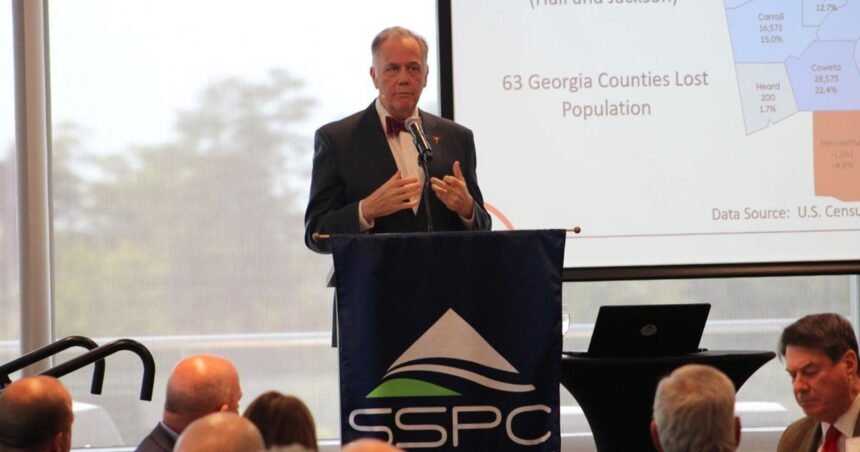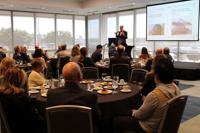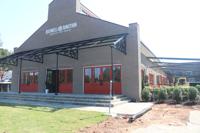SANDY SPRINGS, Ga. — The chief economist for the Metro Atlanta Chamber says indications point to a more stable economy, and Georgia is positioned to reap the benefits.
Speaking before a crowd of some 50 business leaders at Sandy Springs Perimeter Chamber’s Oct. 15 Signature Luncheon, Jerry Parrish painted a cautiously optimistic picture for the metropolitan area and its surrounding counties.
Parrish, former chief economist and director of research at Florida State University’s Institute of Government and the Florida Chamber Foundation, joined the Metro Atlanta Chamber in August 2023.
He said one of the big projects at the chamber is matching demand from companies with talent in the workforce.
“That was one of the things that attracted me to the Metro Atlanta Chamber,” he said.
With several trade and technical schools, as well the University System of Georgia’s 26 public institutions, companies from around the world are considering a move to Metro Atlanta.
Parrish said the millionaires in Generation Z may be electricians and plumbers, instead of those with college degrees. He encourages high schoolers to learn business and a trade.
“Private equity is going around and buying these companies up,” Parrish said. “The prices are not going to go down.”
Even with 63 Georgia counties, or 40 percent of the state, losing residents from 2010-23, the state’s overall population jumped 12.2 percent.
The Atlanta-Sandy Springs-Roswell metropolitan statistical area, covering the 29-county region surrounding Atlanta, saw its population increase 19 percent over the same period.
Growing job numbers and increasing population in the U.S. Census Bureau’s 29-county metropolitan statistical area contrasts with more concerning trends in rural counties, which are losing young people to urban centers and their tax bases with it.
“One of the things you have to look at, as far as how attractive areas are, is how many people are moving there,” Parrish said. “When you add up Fulton, DeKalb, Cobb and Gwinnett counties, that’s seen an increase of right at a half a million people just in that 13-year period.”
Since 2020, Metro Atlanta has seen a 7.2 percent job growth rate, which is more than the state average of 6.6 percent and national mean of 4.5 percent.
Attendees of the Sandy Springs Perimeter Chamber’s Oct. 15 Signature Luncheon listen to a presentation from Jerry Parrish, chief economist of the Metro Atlanta Chamber. The keynote speaker covered the overall health of the U.S. economy, the Federal Reserve’s recent rate cut and regional trends.
“That means Georgia has grown substantially more jobs than the average state out there,” Parrish said. “That probably won’t surprise you that this area is growing, [and] people still want to live here.”
Before jumping into interest rates, inflation and Federal Reserve policy, Parrish said that he and his colleagues have been wrong, and not just a little.
“If you’ll remember back to early 2023, about 85 percent of economists were forecasting a recession,” he said. “All the probabilities said we would be in a recession by the middle of 2023 … that kept getting postponed.”
Parrish said the historically reliable indicator for a looming recession is an inverted yield curve, a condition in which interest rates on long-term bonds are lower than short-term bonds.
“That makes no sense … because if I’m going to loan you money, the longer the duration or period, the more risk you take,” he said. “Every time we’ve had a recession, we’ve had a yield curve inversion right before it.”
After the national economy avoided recession last year, Parrish said economists didn’t know what to think.
“We were all wrong and looked like idiots,” he said. “What happens is the yield curve should start low and go high … now the 10-year is higher than the 2-year [treasury yields].”
With the Federal Reserve announcing an interest-rate cut of 50 basis points Sept. 18, Parrish said he thinks the targeted “soft landing” is looking like more of a possibility.
The Fed is the central banking system in the United States. When Congress established it in 1913, the Fed was tasked with maximizing employment, stabilizing prices and moderating long-term interest rates.
A “soft landing” occurs when the Fed increases interest rates and manages to bring down inflation without causing unemployment to spike or national gross domestic product to drop.
Depending on an individual’s income level and wealth, economic headwinds appear different.
A normal yield curve is beneficial to banks and commercial developers, but what about people outside of those industries?
The job market is doing well, and the Fed doesn’t need to cut rates quickly because it has improved the chances of a soft landing, Parrish said.
Parrish is concerned about a few things in the national economy, like consumer confidence at its lowest level in three years and $34.8 trillion in federal debt.
“Consumers have been through a couple years of inflation,” he said. “Everybody was running a little nervous there for a while, but what’s happening to consumer sentiment is a big deal.”
Confidence was high early in the COVID-19 pandemic before inflation hit consumers.
Even with interest rates coming down and inflation cooling off, most Americans are struggling to make ends meet, excluding most homeowners in North Fulton County.
Parrish cited a few statistics to back that up, like 18.1 percent of customers signing 84-month auto loans.
“There’s straining going on in the economy right now, we have to think about it,” he said. “Even the robots aren’t as busy as they used to be, so what does that tell you, probably things are slowing down.”
Parrish said he doesn’t want to alarm anyone because he thinks the state of Georgia is in a strong position.
“What’s literally happening is we basically have a bifurcated economy here, meaning split in two,” he said. “Take people below median income, they’ve spent all their stimulus money … inflation, food and rent have gone up substantially.”
Parrish said 50 percent of Americans believe the country is already in a recession.
“They’re struggling,” he said. “The last two and a half years, I’ve been forecasting that the Federal Reserve will keep interest rates higher for longer.”
















